Air filters are the main parts of Air Purifier. Types of Air filters in the air purifiers define the capabilities of Air purifier. Each type of filter has unique capabilities. These filters operate based on various mechanisms to capture contaminants and prevent them from circulating in indoor spaces.
Different types of air filters, each designed to address distinct air quality concerns. Mechanical filters, adsorbent filters, electronic air filters, and hybrid systems present a spectrum of filtration methods, while other filters introduce innovative technologies that provide comprehensive solutions. Within these air filter categories, you’ll find the high-efficiency particulate air (HEPA) filters, activated carbon filters, electrostatic precipitators, and much more.
In this article of Types of Air Filters, we will go into the primary air filter categories, their unique mechanisms, and the considerations that guide air purifier filter selection.
Primary Different Types of Air Filters
When it comes to air filters, there are wide range of air purifier filter types option available, each designed to tackle specific air quality challenges.
Mechanical Filters
Mechanical filters rely on physical barriers to trap and remove airborne contaminants. They are highly effective in capturing a wide range of particles, making them popular choices for maintaining clean and healthy indoor air. Within the category of mechanical filters, two prominent air purifier filter types are High-Efficiency Particulate Air (HEPA) filters and Pre-Filters
| Filter Types | Description |
|---|---|
| HEPA Filters | High efficiency particulate air filters are renowned for their ability to capture particles as small as 0.3 microns, making them a popular choice for those seeking the purest air. |
| Pre-Filters | Pre-filters are the first line of defense, capturing larger particles and extending the lifespan of the main filter. |
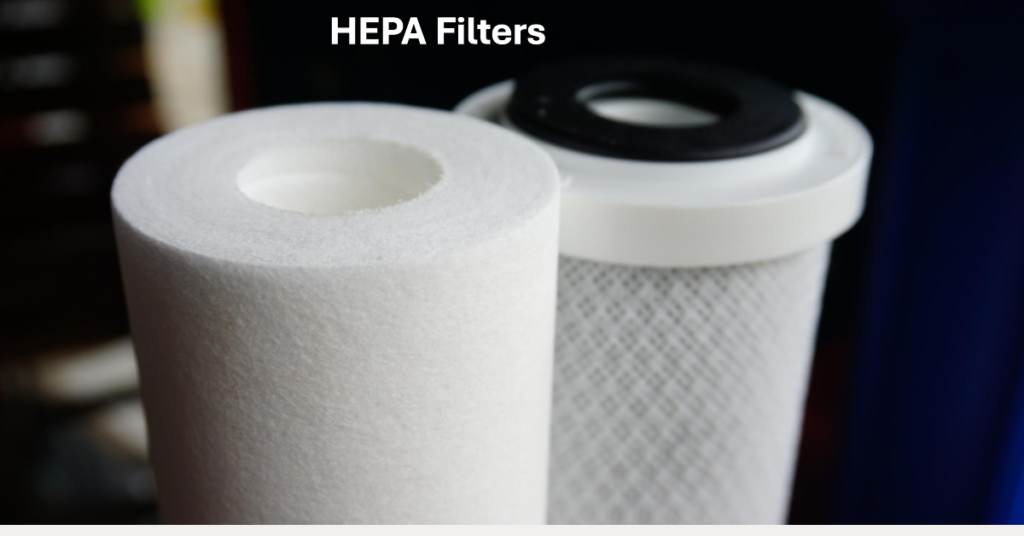
1. HEPA Filters
HEPA filters stands for High Efficiency Particulate Air Filters, and these filters are best known for their ability to capture particles as small as 0.3 microns with an efficiency of around 99.97%. HEPA filters can capture particles hundreds of times smaller than a hair’s width.
These filters are particularly effective at trapping common indoor pollutants such as dust, pollen, pet dander, mold spores, and even some bacteria and viruses. Because of their exceptional particle capturing abilities, HEPA filters are often used in settings where air quality is of high importance, including hospitals, laboratories, and residential spaces. People prefer this filter for purest air quality.
When choosing a HEPA filter always look for the True HEPA label to ensure that you’re getting the highest level of filtration. Regular maintenance and replacement are necessary to keep HEPA filters functioning at their best and maintaining optimal indoor air quality.
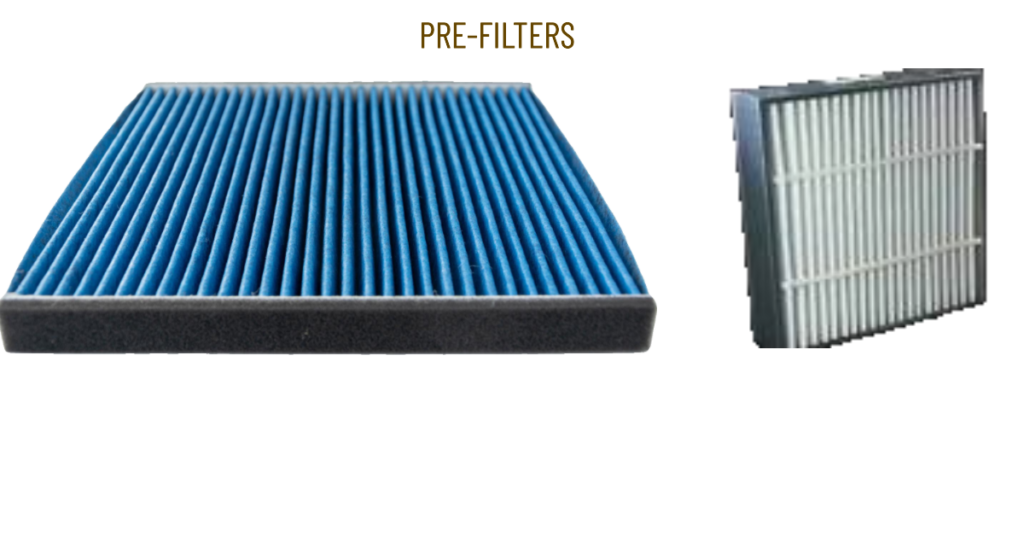
2. Pre-Filters
Pre filters are an integral part of many air purification systems. Pre filters work in tandem with primary filters like HEPA filters. While they may not possess the same microscopic particle-capturing capabilities as HEPA filters, pre-filters serve a vital role in extending the lifespan and efficiency of the main filter. They are typically made of a fibrous material that can trap larger particles, such as dust, hair, and pet fur, before they reach the HEPA filter.
By capturing these larger particles, pre-filters prevent them from clogging the HEPA filter, which is specifically designed for finer particulate matter. This not only improves the overall efficiency of the air purification system but also reduces the frequency of filter replacements. Regularly changing and cleaning pre-filters is a simple maintenance task that can significantly impact the longevity and performance of your air purifier.
Pre-filters are especially beneficial in households with pets or in areas where dust and larger particles are prevalent. They are a cost-effective way to enhance the performance of your air filtration system and ensure that the primary filter can focus on capturing the smallest and most harmful particles in the air.
For your information Pre-filters can come in various forms, including washable and disposable options. The choice between washable and disposable pre-filters depends on your specific needs and preferences. Washable pre-filters can be cleaned and reused, disposable ones offer the convenience of easy replacement. We would suggest fo for washable pre filters, as you can reuse them.
Adsorbent Filters
Adsorbent filters are a distinct air filter categories that excel at removing specific types of contaminants from the air. Mechanical filters physically trap particles, but adsorbent filters work through adsorption, where molecules adhere to the filter’s surface. This makes them highly effective at capturing odors and harmful gases. Within the adsorbent air filter categories, we have several notable air filter types, including Activated Carbon Filters, Silver-Ion Filters, and Titanium Dioxide (TiO2) Filters.
| Filter Type | Description |
|---|---|
| Activated Carbon Filters | Activated carbon filters adsorb and neutralize different chemical compounds, making them ideal for removing odors and VOC’s. |
| Silver-Ion Filters | Silver-ion filters provide an additional layer of preotection against bacteria and microorganisms. |
| Titanium Dioxide (TiO2) Filters | Titanium Dioxide filters uses the power of photocatalysis to break down and neutralize pollutants in the air. |
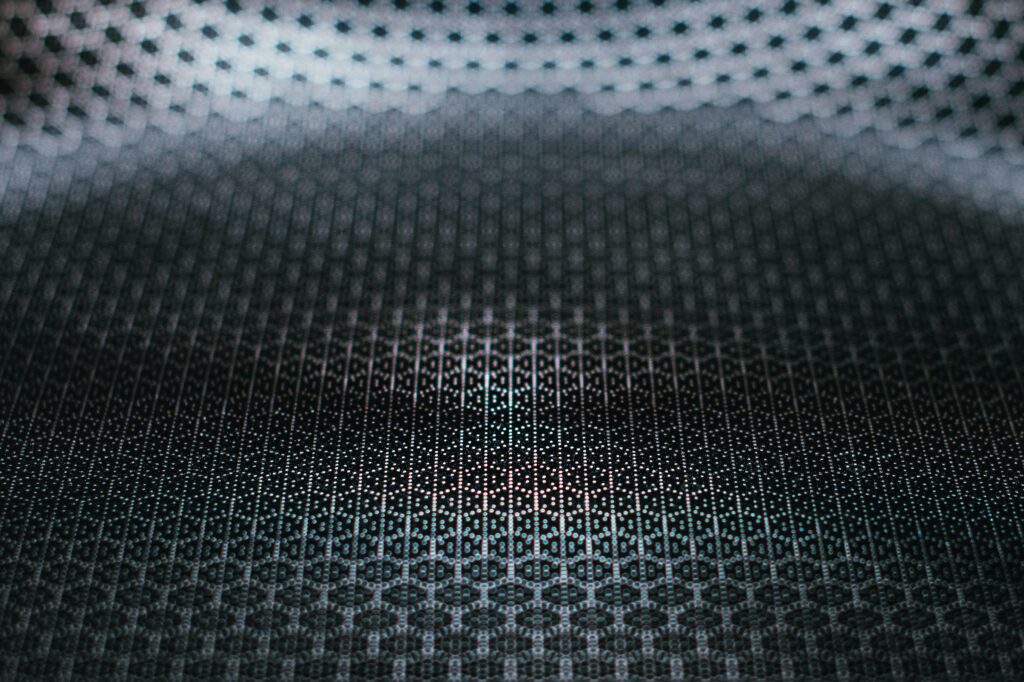
1. Activated Carbon Filters
Activated carbon filters are known for their exceptional ability to adsorb a various chemical compounds, making them popular choices for eliminating odors, volatile organic compounds (VOCs), and other various harmful gases. The term “activated” refers to the carbon’s treatment to increase its surface area, allowing it to adsorb more molecules effectively.
These filters are widely used in homes, offices, and industrial settings to remove unpleasant odors, such as those from cooking, pets, and tobacco. They are also highly effective in removing harmful chemicals like formaldehyde and benzene. Activated carbon filters work through a process where the molecules in the air are attracted to the carbon’s porous structure and held in place, effectively purifying the air. However, it’s essential to replace these filters regularly to maintain their efficiency, as they can become saturated with adsorbed molecules over time.
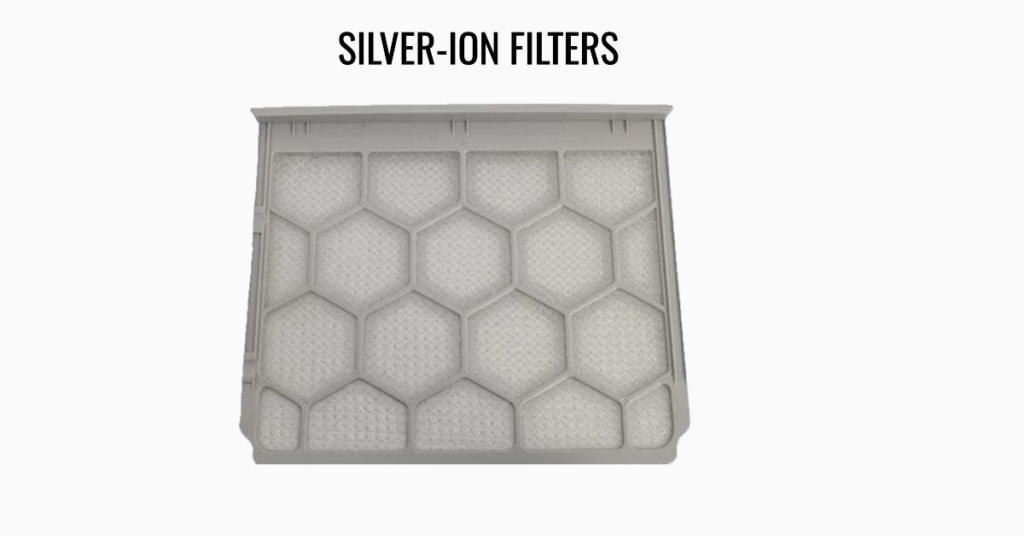
2. Silver-Ion Filters
Silver-ion filters incorporate silver, a natural antimicrobial agent, into the filtration process. Silver ions are released into the air, where they come into contact with and disrupt the cell membranes of microorganisms, preventing their growth and reproduction. Silver ion filters are designed with the specific aim of eliminating bacteria and microorganisms in the air.
Silver-ion filters are commonly used in healthcare settings, laboratories, and spaces where maintaining a sterile environment is important. They are good at controlling the spread of bacteria, viruses, and other pathogens in the air, contributing to a healthier indoor atmosphere. These filters provide an additional layer of protection against airborne microorganisms and can be especially beneficial for individuals with compromised immune systems or those who are particularly health-conscious.
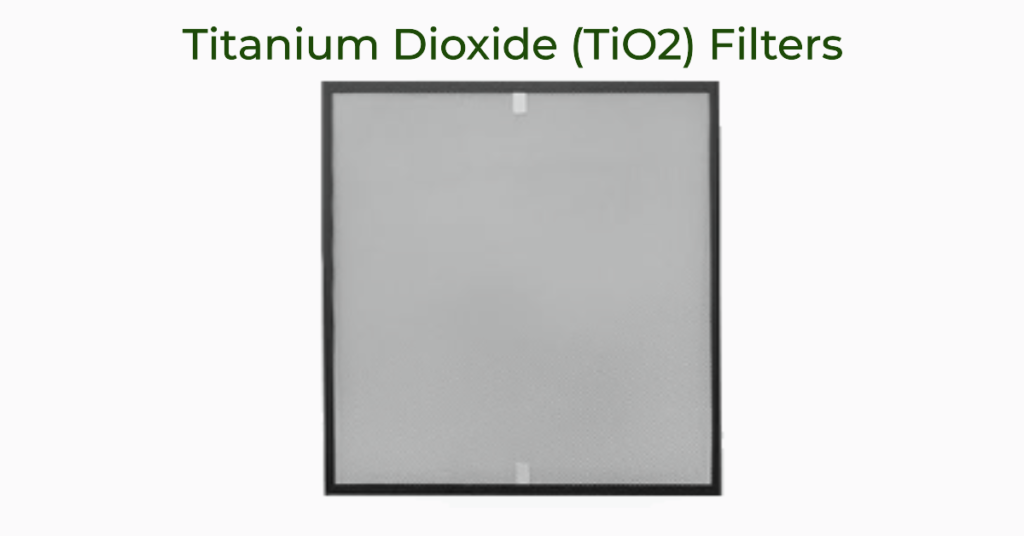
3. Titanium Dioxide (TiO2) Filters
Titanium dioxide (TiO2) filters utilises the power of photocatalysis to break down and neutralize air pollutants. Photocatalysis is a process in which a catalyst, titanium dioxide, is activated by light to speed up a chemical reaction. When TiO2-coated filters are exposed to ultraviolet (UV) light, they trigger a reaction that converts harmful substances like VOCs and bacteria into harmless byproducts.
These filters are known for their ability to fight indoor air pollution and odors effectively. They are used in various applications, including air purifiers, HVAC systems, and even self-cleaning surfaces in homes and commercial spaces. TiO2 filters provide a continuous and low-maintenance solution for maintaining clean indoor air by harnessing the power of light to neutralize contaminants.
Electronic Air Filters
Electronic air filters are known for their effectiveness in capturing particles and pollutants, providing an excellent solution for maintaining clean and healthy indoor air. Within the electronic air filter categories, several notable air filter types include Electrostatic Precipitators (ESP), Ionizing Filters, and those equipped with PlasmaWave Technology.
| Filter Type | Description |
|---|---|
| Electrostatic Precipitators (ESP) | Electrostatic precipitators use electrically charged plates to attract and trap particles, offering efficient air purification. |
| Ionizing Filters | Ionizing filters release negative ions to make particles clump together, making them easier to capture. |
| Plasma Filters | Plasma filters utilize high-voltage electrical discharge to break down and neutralize pollutants in the air, contributing to cleaner air. |
| PlasmaWave Technology | PlasmaWave technology combines the benefits of ionization and plasma to enhance air purification. |

1. Electrostatic Precipitators (ESP)
Electrostatic precipitators (ESP) are electronic air filters which use the principles of electrostatic attraction to capture particles in the air. These filters consist of two charged plates: one positively charged and one negatively charged. As air passes through the filter, particles become charged, and they are then attracted to the oppositely charged plates. This process results in the efficient removal of particles from the air, including dust, allergens, and even some microorganisms.
ESP filters are known for their high-efficiency particle removal and are especially effective at capturing fine particles that may escape other types of air filters. They are commonly used in both residential and commercial settings, and they require periodic cleaning to maintain their efficiency. ESP filters are highly effective, but they can also produce ozone as a byproduct, so it’s important to ensure they meet safety standards and don’t generate excessive ozone levels.
2. Ionizing Filters
Ionizing filters use the power of ions to remove contaminants from the air. These filters release negative ions into the air, which attach to airborne particles, giving them a negative charge. The negatively charged particles are then attracted to positively charged surfaces, including collection plates or other filter elements. This process effectively removes particles from the air and can even help neutralize some odors.
Ionizing filters are particularly useful in homes and workplaces where dust, pollen, and allergens are common concerns. They are known for their ability to capture particles as small as 0.1 microns, making them effective against fine particulate matter. Maintenance typically involves cleaning or replacing collection plates as needed to ensure consistent performance.
3. Plasma Filters
Plasma filters are electronic air filters that generate a high voltage electrical field to create plasma(a highly reactive gas composed of ions, electrons, and free radicals). This plasma interacts with airborne particles, breaking down pollutants and microorganisms at a molecular level. The byproducts of this process are harmless and contribute to purifying the air.
Plasma filters are efficient at removing a wide range of contaminants, including bacteria, viruses, mold spores, and even odors. They are often used in environments where air quality is a top priority, such as healthcare facilities, laboratories, and residences. Plasma filters are considered low-maintenance, and their effectiveness in neutralizing harmful agents in the air makes them a valuable choice for improving indoor air quality.
4. PlasmaWave Technology
PlasmaWave technology is an advanced feature integrated into some electronic air filters. It combines the principles of plasma generation with the addition of water vapor to create hydroxyl radicals. These hydroxyl radicals react with and neutralize a broader spectrum of airborne pollutants, providing an extra layer of protection.
PlasmaWave technology is designed to address not only particulate matter but also gases, VOCs, and various odors. It is a comprehensive solution for maintaining pristine indoor air quality and is often featured in high-end air purifiers. Regular maintenance typically involves cleaning the collection plates or filter components to ensure consistent performance and efficiency.
Electronic air filters offer cutting-edge technologies to effectively remove particles and pollutants from the air. Electrostatic precipitators (ESP) use electrostatic attraction, ionizing filters rely on ions to capture particles, and plasma filters harness plasma to break down contaminants. PlasmaWave technology combines the power of plasma and hydroxyl radicals for a more comprehensive air purification solution. Each of these electronic air filters plays a vital role in ensuring that your indoor air is free from a wide range of pollutants, contributing to a healthier and more comfortable living environment.
Hybrid Filters
Hybrid filters are advanced air filtration systems that combine multiple technologies to provide comprehensive purification. These hybrid systems leverage the strengths of different filtration methods to effectively remove a wide range of contaminants from the air. Among the hybrid filters, we have several prominent air filter types, including ESP Filtration with UV-C, PECO Filters, Photocatalytic Fiber Filters, Photocatalytic Oxidation (PCO) Filters, and UV-C Filters.
| Air Filter Types | Description |
|---|---|
| ESP Filtration with UV-C | Combining electrostatic precipitators with UV-C light ensures comprehensive particle capture and sterilization. |
| PECO Filters (Photo Electrochemical Oxidation) | PECO filters use photo electrochemical oxidation to effectively eliminate pollutants, contributing to cleaner indoor air. |
| Photocatalytic Fiber Filters | Photocatalytic fiber filters leverage the power of light and catalysts to break down and neutralize contaminants in the air. |
| Photocatalytic Oxidation (PCO) Filters | PCO filters utilize photocatalytic oxidation to enhance air purification by neutralizing pollutants. |
| UV-C Filters (Ultraviolet Germicidal Irradiation) | UV-C filters employ ultraviolet germicidal irradiation to destroy microorganisms, making them a reliable choice for germaphobes. |
1. ESP Filtration with UV-C
ESP filtration with UV-C combines the principles of electrostatic precipitators (ESP) and ultraviolet germicidal irradiation (UV-C) to achieve superior air purification. ESP filters effectively capture particulate matter through electrostatic attraction, while UV-C light is used to sterilize the air by deactivating microorganisms such as bacteria, viruses, and mold spores.
This hybrid approach is particularly effective in healthcare settings, laboratories, and other high-risk environments where maintaining sterile air is essential. The combination of ESP filtration and UV-C sterilization ensures both particle removal and microorganism deactivation, providing a comprehensive solution for improving indoor air quality.
2. PECO Filters (Photo Electrochemical Oxidation)
PECO filters, or Photo Electrochemical Oxidation filters, employ a unique technology that goes beyond traditional filtration. These filters use a chemical reaction initiated by UV-A light to break down and neutralize a wide spectrum of pollutants, including VOCs, bacteria, viruses, and mold spores.
PECO filters are celebrated for their ability to address gaseous pollutants, which many other filters may not effectively capture. They are often found in air purifiers designed for homes and offices, where comprehensive air purification is required. Regular maintenance typically involves replacing the filter component to ensure continued efficiency.
3. Photocatalytic Fiber Filters
Photocatalytic fiber filters utilize a photocatalytic process to degrade pollutants in the air. These filters are typically coated with a substance like titanium dioxide (TiO2), which, when exposed to UV-A light, triggers a reaction that breaks down contaminants into harmless byproducts. This technology effectively addresses odors, VOCs, and even bacteria.
Photocatalytic fiber filters are commonly used in homes, particularly in air purifiers, where odor control and comprehensive air purification are important. They offer a continuous and low-maintenance solution for improving indoor air quality by neutralizing a wide range of contaminants.
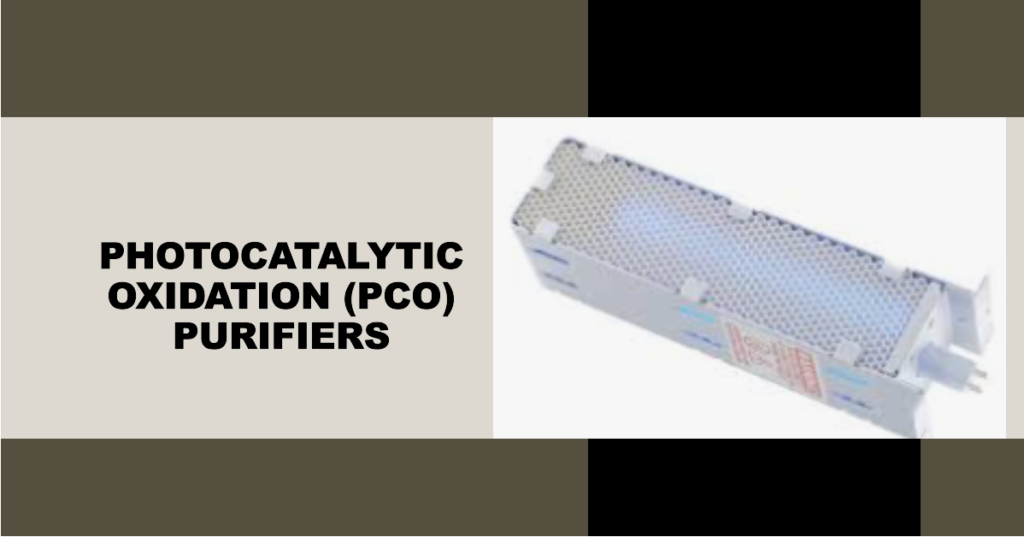
4. Photocatalytic Oxidation (PCO) Filters
Photocatalytic oxidation (PCO) filters build on the principles of photocatalysis to oxidize and decompose airborne pollutants. These filters are often used in conjunction with UV-A light to activate the photocatalytic process. The result is the breakdown of various contaminants, including VOCs, bacteria, and viruses, into harmless substances.
PCO filters are versatile and can be found in various settings, from residential air purifiers to industrial applications. They provide an effective means of eliminating a wide range of indoor air pollutants and contributing to a healthier indoor environment. Maintenance typically involves periodic replacement of the filter component to ensure optimal performance.
5. UV-C Filters (Ultraviolet Germicidal Irradiation)
UV-C filters, or Ultraviolet Germicidal Irradiation filters, leverage the germicidal properties of UV-C light to deactivate microorganisms in the air. UV-C light emits short-wavelength ultraviolet radiation, which damages the genetic material of bacteria, viruses, and mold spores, preventing them from reproducing.
UV-C filters are commonly used in healthcare facilities, laboratories, and places where maintaining sterile air is a priority. They are highly effective at reducing the spread of infections and illnesses by neutralizing airborne pathogens. Maintenance typically involves periodically replacing the UV-C lamps to ensure continued effectiveness.
Hybrid filters represent a cutting-edge approach to air purification by combining multiple technologies to address a wide range of contaminants. ESP filtration with UV-C, PECO filters, photocatalytic fiber filters, PCO filters, and UV-C filters offer versatile and efficient solutions for maintaining clean and healthy indoor air. These hybrid systems are particularly valuable in environments where comprehensive air purification is a top priority, contributing to a safer and more comfortable living or working space.
Other Types of Air Filters
Within the realm of air filtration, there are various other filters and technologies designed to address specific air quality concerns. These options go beyond traditional mechanical and electronic filters, offering alternative methods to achieve clean and healthy indoor air. The categories of other filters include Antibacterial Filters, Multi-Stage Filtration, Ozone Generators, and Nanofiber Filters.
| Air Filter Types | Description |
|---|---|
| Antibacterial Filters | Antibacterial filters actively combat harmful bacteria and microorganisms, contributing to a healthier indoor environment. |
| Multi-Stage Filtration | Multi-stage filtration systems use a combination of various filters to ensure thorough air purification. |
| Ozone Generators | Ozone generators, despite some controversy, are still used for their ability to eliminate odors and purify the air. |
| Nanofiber Filters | Nanofiber filters use ultra-fine fibers to capture even the most elusive particles, ensuring the air is as pure as it can be. |
1. Antibacterial Filters
Antibacterial filters are designed with the specific aim of preventing the growth and spread of harmful bacteria and microorganisms in the air. These filters typically incorporate antibacterial agents or coatings that inhibit the growth of bacteria and prevent them from reproducing. This results in air that is not only free from airborne contaminants but also less likely to harbor pathogens.
Antibacterial filters are commonly used in healthcare settings, laboratories, and areas where maintaining a sterile environment is paramount. They are highly effective at reducing the risk of infections and illnesses by neutralizing bacteria and other microorganisms in the air. Maintenance usually involves periodic replacement to ensure ongoing effectiveness.
2. Multi-Stage Filtration
Multi-stage filtration systems employ a combination of air purifier filter types and technologies to provide comprehensive air purification. These systems typically consist of a series of filters arranged in stages, each targeting specific types of contaminants. This approach allows for the removal of a wide range of particles, gases, and odors from the air.
Multi-stage filtration is commonly found in high-end air purifiers and HVAC systems, where maintaining top-tier air quality is a priority. The stages may include pre-filters, HEPA filters, activated carbon filters, and other specialized filters. Regular maintenance involves replacing or cleaning each filter in the system as needed to maintain peak performance.
3. Ozone Generators
Ozone generators are devices that produce ozone, a molecule composed of three oxygen atoms. Ozone is used to neutralize odors, bacteria, and other pollutants in the air. When ozone is released into the environment, it reacts with airborne contaminants, breaking them down and eliminating odors and harmful substances.
AirPurifier with Ozone generators are often used in commercial and industrial settings where odor control and air purification are essential. However, it’s important to use ozone generators with caution, as high ozone levels can be harmful to human health. Regular maintenance may involve ensuring the proper calibration and functioning of the device to avoid excessive ozone production.
4. Nanofiber Filters
Nanofiber filters are air filter types designed to capture even the smallest airborne particles. These filters are composed of nanoscale fibers, which are significantly smaller in diameter than those in traditional filters. This small fiber size enables nanofiber filters to trap particles as small as 0.1 microns, making them exceptionally effective at removing fine particulate matter.
Nanofiber filters find applications in environments where airborne particulate matter poses health risks. They are often used in cleanrooms, laboratories, and in manufacturing processes where maintaining air quality is critical. Maintenance typically involves replacing the nanofiber filter element periodically to ensure efficient particle capture.
Other filters represent a diverse set of air purification solutions beyond traditional mechanical and electronic filters. Antibacterial filters inhibit the growth of bacteria and microorganisms, providing a sterile air environment. Multi-stage filtration systems combine different kinds of air filters for comprehensive air purification. Ozone generators use ozone to neutralize odors and pollutants, while nanofiber filters excel at capturing even the tiniest airborne particles. Each of these air filter types offers unique benefits for addressing specific air quality concerns and contributes to cleaner and healthier indoor air.
Conclusion
As we discussed in this article different types of air filters play a crucial role in ensuring the air you breathe is clean, fresh, and free from harmful particles. Whether you opt for a HEPA filter for superior particle capture, an activated carbon filter to eliminate odors, or an electronic filter with innovative technologies, your choice can significantly impact your indoor air quality.
So, next time you shop for an air filter, remember the options of air filter types available and choose the one that best suits as per your air purification needs.
FAQ
What are the main types of air filters available?
The main types of air filters include HEPA (High-Efficiency Particulate Air) filters, activated carbon filters, and UV (Ultraviolet) filters.
What are fiberglass air filters, and how do they work?
Fiberglass air filters consist of multiple layered fiberglass fibers designed to capture larger particles such as dust and lint. They work by trapping particles as air passes through the filter, but they are less effective at capturing smaller particles compared to other types of filters.
What are pleated air filters, and what are their advantages?
Pleated air filters are made with pleated synthetic materials like polyester or cotton, providing a larger surface area for particle capture. They offer better filtration efficiency than fiberglass filters and can trap smaller particles such as pollen and mold spores. Pleated filters also tend to have a longer lifespan and are more durable.
Which type of air filter is best for allergy sufferers?
HEPA filters are mostly recommended for allergy sufferers due to their high efficiency in capturing allergens such as pollen, dust mites, and pet dander.
DheerajSonwane is a dedicated writer with expertise in air purification technologies. He focuses on providing well-researched content to help readers improve indoor air quality in homes and businesses. As the lead writer at AirPurifierMaster.com, Dheeraj offers practical advice his insightful reviews guide individuals in choosing the best air purifiers for their needs.


1 thought on “Types of Air Filters: A Comprehensive Guide”